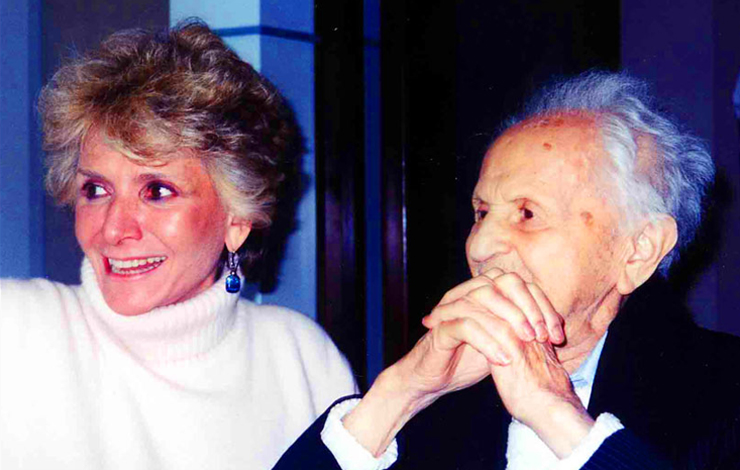
On September 2, 2003, a remarkable film made its way to HBO. The journey is worth retelling. In the spring of 2001, three Columbia University graduate students—Stefan Knerrich, Michael Rey and Amy Rubin—finished their senior project, a film called 3rd Reich to 3rd Generation. It was the story of Arthur Lederman, a 101-year-old Holocaust survivor who had never had a conversation with a German during his adult life. But when Dorot, a Jewish aid agency, sent German exchange student Christophe Erbsloeh to help Lederman with his daily life, a dialogue began that explored the Holocaust through the eyes of a 21-year-old man and one more than 80 years his senior. The Columbia students were there to capture this extraordinary relationship. Before he was forced from his native Poland in 1938 Lederman was a renowned concert violinist. Erbsloeh is a budding cellist. From their first painful conversations, they discovered that while history is unchangeable, they shared a passion for music and art that transcended their differences and their generations.
When the students completed their work, they hoped for a good grade, but they got a good deal more. The film won numerous student awards, including the Academy of Television Arts and Sciences' Student Film Award. But it also was seen by acquisitions executives at CameraPlanet Pictures. What everyone agreed was that the material had the bones of a great doc. And the filmmakers found themselves committed to turning what had been a labor of love into a finished documentary feature. That required new eyes.
How was this story important to a broad audience? Where was the line between sharing the "facts" and delving into the emotion? As a piece of journalism, the film followed a strict chronology. To illuminate the film's central characters, the filmmakers would take more liberties with time, thereby enabling the dramatic arc and a more effective narrative.
Rubin, Rey and Knerrich worked night and day for three months. They found new pictures. They added new narration by Susan Sarandon. They trimmed the student film elements that included a "newsy" narration track and a sidebar story about a trip to Germany. The Lederman and Erbsloeh story became the basis for the film.
Along with senior producer Lori Fechter, writer Ed Fields and editor Mark Senter, I fell in love with Lederman and his story. Each of us watched cuts and suggested polishes, but never did anyone get in the way of the filmmakers'vision.
But we did change the name. The film became Facing Arthur, as Erbsloeh faced both a man of extraordinary strength and the past that his German relatives refused to discuss. When it was finished, the film began to find its way to festivals, winning numerous awards along the way.
With such creative momentum, it seemed that the film would find a passionate advocate at a network. And it did. Lisa Heller at HBO saw the film and recommended it to Sheila Nevins, HBO's executive vice president for original programming. Nevins was quick with her praise and excited to embrace the film. And she had some ideas about how to make it even stronger. "Shelia would have notes," we were told.
For a filmmaker and distributor, notes from a network are always a cause for concern. Will they meddle? Will they take out elements that the filmmakers love? Will they twist it into something it is not?
After more than a year of work, the team at HBO would be the third group of creative personnel to get involved in the film. The HBO executives had some clear direction. They preferred simple art cards to our narration. They wanted to learn more about Lederman's spirit, art and philosophy. They wanted less history and more character development—and more about the core story of Lederman and his relationship with Erbsloeh. But the direction was always couched in terms that kept the filmmakers feeling like their vision was being respected. For first-time filmmakers this respect was deeply appreciated. HBO wanted to make a film that would connect with a larger audience, and the filmmakers took the direction with the spirit in which it was offered.
HBO brought in Geof Bartz, one of their most experienced documentary editors, to consult on the project. And while he worked closely with the filmmakers, he never ended up cutting the film.
Sometimes a film needs a fresh pair of eyes to let the spirit of the material shine through. The dynamic of this process was surprisingly friction-free. What HBO loved about the film was very much in sync with the filmmakers' vision, and the team worked hand in hand to bring that vision to the screen.
Filmmakers. A distributor. A network. And in each set of hands the film became stronger. In the end what emerged was a triumph in both filmmaking and distribution, with the core vision of the filmmakers clearly at the fore.
It doesn't always work that way. But when it does, audiences are treated to a piece of work that is engaging and magical. And that's how it is supposed to be.
Steve Rosenbaum can be reached at Steve.Rosenbaum@CameraPlanet.com.
